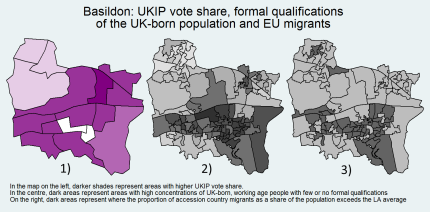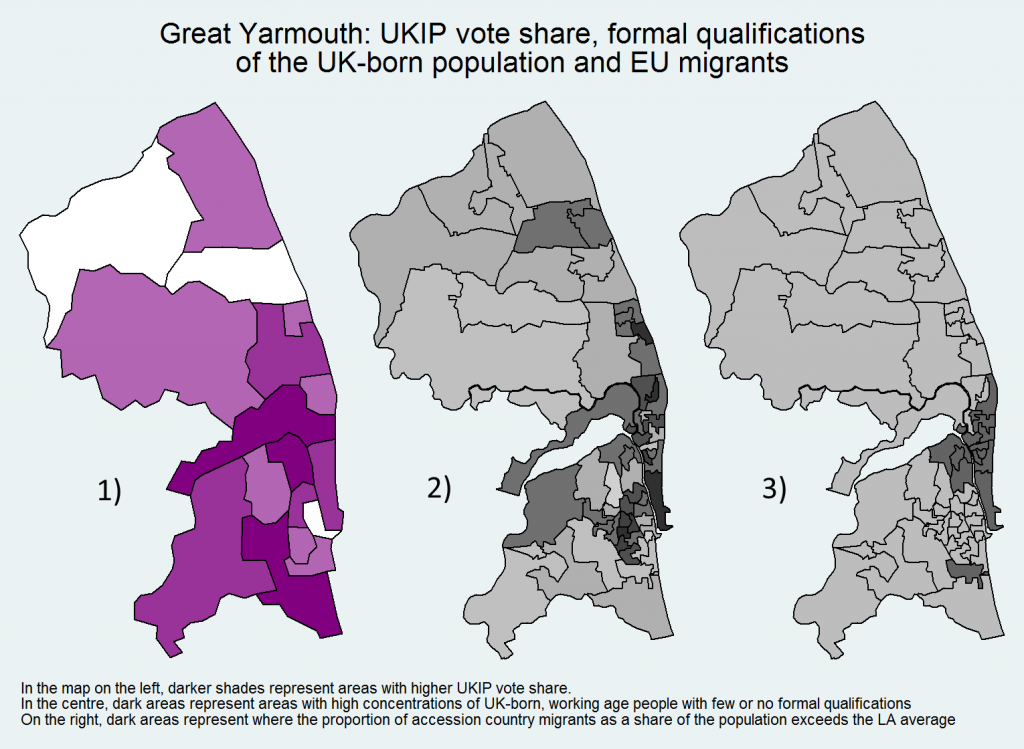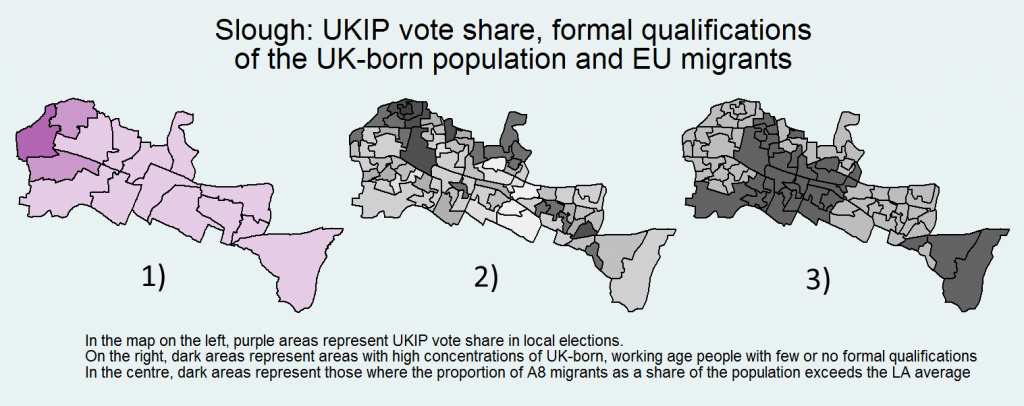 Looking at data at the ward level on qualifications and immigration, Steven Ayres finds that UKIP support seems to be affected by the interaction effect between accession country diasporas and poorly qualified UK-born residents. Evidence from areas that UKIP have not done quite as well appears to reinforce this idea.
Looking at data at the ward level on qualifications and immigration, Steven Ayres finds that UKIP support seems to be affected by the interaction effect between accession country diasporas and poorly qualified UK-born residents. Evidence from areas that UKIP have not done quite as well appears to reinforce this idea.
Speculation regarding the how, why, and who of UKIP successes over recent years has continued to amass over the four months since the 2014 elections. The by-elections in the constituencies of Heywood and Middleton and Clacton have added further fuel to the debate.
The party gained its first elected MP with the election of Douglas Carswell in Clacton, winning with a majority of 12,404 votes. This majority (over 48% above the UK average in the 2010 General Election) is roughly the same size as that enjoyed by Carswell when he stood for the Conservative party in Clacton in 2010 (UKIP did not field a candidate in this constituency in the general election). In Heywood and Middleton, the Labour candidate Liz McInnes took the seat with 40.1% of the vote, roughly the same Labour share as in 2010 but with a reduced majority of 617 compared to 5,971 in the general election. Turnout fell in both constituencies relative to 2010, by 13 percentage points in Clacton and 21.5 percentage points in Heywood and Middleton (although turnout is usually lower in by-elections).
So what might these results tell us? As noted in a recent post, UKIP has registered its most resounding achievements in a limited number of local areas, yet there is little obvious connection that links these areas. Attention has been drawn to UKIP’s supposed “seaside strategy” of targeting certain coastal areas of England, which may indeed prove the best chance of securing seats in next year’s election. Yet as the map below shows, there is little discernible pattern in terms of the geographic distribution of local authorities with UKIP councillors around England.
Figure 1: Local Authorities with UKIP councillors as of May 2014
So if not along party or geographical lines, what do the areas with higher levels of UKIP support have in common? In their book, Revolt on the Right, Matthew Goodwin and Robert Ford draw attention to what they call the “left behind” portion of society – those groups that have struggled to keep pace with the rapid changes to the social, economic and political landscape in the country over recent years. As the authors state, “UKIP’s radical revolt is anchored in a clear social base: older, blue-collar voters, citizens with few qualifications, whites and men”.
This article will focus on combining data on one of these issues, qualifications, with data relating to another core issue that polling suggests is motivating voters – immigration. In a poll conducted by Lord Ashcroft following the May European elections, the top issue that UKIP voters said would determine how they vote in next year’s election was immigration (with 70% of polled UKIP voters saying so). While there are an infinite number of social, economic, demographic and cultural factors that influence the choices of voters, could there be a connection between UKIP support, skills and immigration?
UKIP support, skills and immigration
The set of maps below show three different variables:
1) UKIP vote share in the 2014 local elections (by ward);
2) The proportion of the population with no formal qualifications or Level 1 (equivalent to 1 to 4 O Levels/CSE/GCSEs);
3) Those areas that have a higher concentration of migrants from the countries that have joined the EU since 2001 (including Czech Republic, Estonia, Hungary, Latvia, Lithuania, Poland Slovakia, Slovenia, etc.) than the Local Authority average.
It is important to note that a relationship between two variables does not necessarily mean that the change in one causes the change in the other – we are merely observing a limited set of characteristics of an area.
By comparing maps 1 and 2, it appears that UKIP support is concentrated in and around the areas where the UK-born population have little or no formal qualifications. This may offer support for Goodwin and Ford’s ideas in that people at the lower end of the qualifications spectrum appear to be voting for UKIP more than others. Map 3 introduces another dynamic to this observation in that migrants from EU accession countries tend to be focused in the same areas. It is important to note that not all areas will conform to this pattern – in the case of Heywood and Middleton there are areas in the east of the constituency with low qualifications and a concentration of EU migrants but no 2014 council candidate for UKIP. The key point is that the general distribution relating to these characteristics appears to be in line with UKIP support.
There have been no recent local elections in the Local Authority of Tendring (of which Clacton forms a part) so we are unable to compare with UKIP vote shares. However, Map 1 above shows the high proportion of the UK-born, over-16 population in Clacton that have Level 1 or no formal qualifications. At 54% this figure stands as the third highest among local authorities in England and compares with 44% in Heywood and Middleton and an England average of 37%. Again, the population of accession country migrants is focused in the same areas as those where the UK-born population have the fewest qualifications.
Do other areas agree with this pattern?
In my previous post I focused on three local authorities where UKIP made particularly significant gains in the local elections: Basildon, Rotherham and Great Yarmouth. To further this analysis I will begin by looking at Basildon. The case of Basildon appears to offer further support for a connection between the three variables, with the highest UKIP vote share concentrated in the centre of the local authority, which is also the area with the lowest formal qualifications and highest concentration of accession country migrants. While there are pockets of UKIP support in the north in areas that have fewer migrants, this indicates that there may be a number of factors (including spillover effects) that are beyond the scope of the current analysis.
A similar effect appears to be observable in the case of Great Yarmouth, shown below.
While we cannot be certain that the interaction effect between accession country diasporas and poorly qualified UK-born residents affects UKIP support, evidence from areas that UKIP have not done quite as well appears to reinforce this idea.
Of the 161 local authorities that held elections in May 2014, Slough was the one with the highest proportion of accession country migrants as a share of total population (excluding London). At the time of the 2011 Census the proportion stood at 7%, far greater than the equivalent in Great Yarmouth (1.8%) and Basildon (0.8%). Yet high levels of immigration have translated into little success in Slough, with a single councillor elected in 2014 out of a possible 42 seats.
Map 1 shows that UKIP saw a consistently low vote share across Slough, with the exception of the wards in the North West. While there seems to be little connection with the distribution of accession country migrants as shown in map 3, map 2 reveals that the UK-born residents with the lowest levels of formal qualifications can also be found in this area. This may imply that while immigration is the main motivating factor that UKIP voters cite, high levels of immigration alone may not result to UKIP votes on a large scale.
Note: All data on country of birth and qualifications drawn from 2011 Census. This article was originally published on Second Reading, the House of Commons Library blog, and gives the views of the author, and not the position of the British Politics and Policy blog, nor of the London School of Economics. Please read our comments policy before posting.
 Steven Ayres is a former Economics and Development Consultant with the United Nations in Bangkok and now works as a Statistical Researcher for the House of Commons Library, focusing on the issues of democracy, social security and immigration.
Steven Ayres is a former Economics and Development Consultant with the United Nations in Bangkok and now works as a Statistical Researcher for the House of Commons Library, focusing on the issues of democracy, social security and immigration.














3 Comments